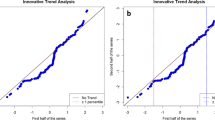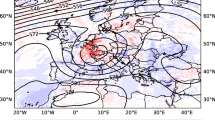Abstract
Daily gridded high-resolution rainfall data of India Meteorological Department at 0.25° spatial resolution (1901–2015) was analyzed to detect the trend in seasonal, annual, and maximum cumulative rainfall for 1, 2, 3, and 5 days. The present study was carried out for 85 river basins of India during 1901–2015 and pre- and post-urbanization era, i.e., 1901–1970 and 1971–2015, respectively. Mann–Kendall (α = 0.05) and Theil–Sen’s tests were employed for detecting the trend and percentage of change over the period of time, respectively. Daily extreme rainfall events, above 95 and 99 percentile threshold, were also analyzed to detect any trend in their magnitude and number of occurrences. The upward trend was found for the majority of the sub-basins for 1-, 2-, 3-, and 5-day maximum cumulative rainfall during the post-urbanization era. The magnitude of extreme threshold events is also found to be increasing in the majority of the river basins during the post-urbanization era. A 30-year moving window analysis further revealed a widespread upward trend in a number of extreme threshold rainfall events possibly due to urbanization and climatic factors. Overall trends studied against intra-basin trend across Ganga basin reveal the mixed pattern of trends due to inherent spatial heterogeneity of rainfall, therefore, highlighting the importance of scale for such studies.











Similar content being viewed by others
References
Adarsh S, Janga Reddy M (2015) Trend analysis of rainfall in four meteorological subdivisions of southern India using nonparametric methods and discrete wavelet transforms. Int J Climatol 35:1107–1124
Barsugli J, Anderson C, Smith JB, Vogel JM (2009) Options for improving climate modeling to assist water utility planning for climate change
Basistha A, Arya DS, Goel NK (2009) Analysis of historical changes in rainfall in the Indian Himalayas. Int J Climatol 29:555–572
Bayazit M, Önöz B (2008) Reply to discussion of “To prewhiten or not to prewhiten in trend analysis?”. Hydrol Sci J 53:669
Bhaskaran B, Mitchell JFB, Lavery JR, Lal M (1995) Climatic response of the Indian subcontinent to doubled CO2 concentrations. Int J Climatol 15:873–892. doi:10.1002/joc.3370150804
Brekke LD, Kiang JE, Olsen JR, et al (2009) Climate change and water resources management—a federal perspective: US Geological Survey Circular 1331, 65 p
Cinco TA, de Guzman RG, Hilario FD, Wilson DM (2014) Long-term trends and extremes in observed daily precipitation and near surface air temperature in the Philippines for the period 1951–2010. Atmos Res 145:12–26
Datta P (2006) Urbanisation in India. In: European Population Conference. Bratislava pp 21–24
Deshpande NR, Kothawale DR, Kulkarni A (2016) Changes in climate extremes over major river basins of India. Int J Climatol. doi:10.1002/joc.4651
Douglas EM, Fairbank CA (2010) Is precipitation in northern New England becoming more extreme? Statistical analysis of extreme rainfall in Massachusetts, New Hampshire, and Maine and updated estimates of the 100-year storm. J Hydrol Eng 16:203–217
Duhan D, Pandey A (2013) Statistical analysis of long term spatial and temporal trends of precipitation during 1901–2002 at Madhya Pradesh, India. Atmos Res 122:136–149
Gocic M, Trajkovic S (2013) Analysis of changes in meteorological variables using Mann-Kendall and Sen’s slope estimator statistical tests in Serbia. Glob Planet Change 100:172–182
Goswami BN, Venugopal V, Sengupta D et al (2006) Increasing trend of extreme rain events over India in a warming environment. Science 314(80):1442–1445
Guhathakurta P, Rajeevan M (2008) Trends in the rainfall pattern over India. Int J Climatol 28:1453–1470
Guhathakurta P, Rajeevan M, Sikka DR, Tyagi A (2015) Observed changes in southwest monsoon rainfall over India during 1901–2011. Int J Climatol 35:1881–1898. doi:10.1002/joc.4095
Haylock M, Nicholls N (2000) Trends in extreme rainfall indices for an updated high quality data set for Australia, 1910–1998. Int J Climatol 20:1533–1541
Jain SK, Kumar V (2012) Trend analysis of rainfall and temperature data for India. Curr Sci 102:37–49
Jena PP, Chatterjee C, Pradhan G, Mishra A (2014) Are recent frequent high floods in Mahanadi basin in eastern India due to increase in extreme rainfalls? J Hydrol 517:847–862
Joshi UR, Rajeevan M (2006) Trends in precipitation extremes over India. National Climate Centre, India Meteorological Department
Kamruzzaman M, Beecham S, Metcalfe AV (2016) Estimation of trends in rainfall extremes with mixed effects models. Atmos Res 168:24–32
Karl TR, Knight RW (1998) Secular trends of precipitation amount, frequency, and intensity in the United States. Bull Am Meteorol Soc 79:231–241
Kendall MG (1948) Rank correlation methods, 4th edn. Charles Griffin, London
Kiely G, Albertson JD, Parlange MB (1998) Recent trends in diurnal variation of precipitation at Valentia on the west coast of Ireland. J Hydrol 207:270–279
Kishtawal CM, Niyogi D, Tewari M et al (2010) Urbanization signature in the observed heavy rainfall climatology over India. Int J Climatol 30:1908–1916. doi:10.1002/joc.2044
Krishnakumar KN, Prasada Rao GSLHV, Gopakumar CS (2009) Rainfall trends in twentieth century over Kerala, India. Atmos Environ 43:1940–1944. doi:10.1016/j.atmosenv.2008.12.053
Kumar KR, Pant GB, Parthasarathy B, Sontakke NA (1992) Spatial and subseasonal patterns of the long-term trends of Indian summer monsoon rainfall. Int J Climatol 12:257–268. doi:10.1002/joc.3370120303
Kumar S, Merwade V, Kam J, Thurner K (2009) Streamflow trends in Indiana: effects of long term persistence, precipitation and subsurface drains. J Hydrol 374:171–183
Kumar V, Jain SK (2011) Trends in rainfall amount and number of rainy days in river basins of India (1951–2004). Hydrol Res 42:290–306. doi:10.2166/nh.2011.067
Kumar V, Jain SK, Singh Y (2010) Analysis of long-term rainfall trends in India. Hydrol Sci J 55:484–496. doi:10.1080/02626667.2010.481373
Lettenmaier DP, Wood EF, Wallis JR (1994) Hydro-climatological trends in the continental United States, 1948–88. J Clim 7:586–607
Mann HB (1945) Nonparametric tests against trend. Econom J Econom Soc:245–259
May W (2002) Simulated changes of the Indian summer monsoon under enhanced greenhouse gas conditions in a global time-slice experiment. Geophys Res Lett 29:1118. doi:10.1029/2001GL013808
Pai DS, Sridhar L 2015 Long term trends in the extreme rainfall events over India, in: High-impact weather events over the SAARC region, Springer International Publishing, Cham, Switzerland with Capital Publishing Company, New Delhi, India, 229–240
Pai DS, Sridhar L, Badwaik MR, Rajeevan M (2015) Analysis of the daily rainfall events over India using a new long period (1901–2010) high resolution (0.25°× 0.25°) gridded rainfall data set. Clim Dyn 45:755–776
Pai DS, Sridhar L, Rajeevan M et al (2014) Development of a new high spatial resolution (0.25° × 0.25°) long period (1901–2010) daily gridded rainfall data set over India and its comparison with existing data sets over the region. Mausam 65:1–18
Pal I, Al-Tabbaa A (2010a) Assessing seasonal precipitation trends in India using parametric and non-parametric statistical techniques. Theor Appl Climatol 103:1–11. doi:10.1007/s00704-010-0277-8
Pal I, Al-Tabbaa A (2011) Monsoon rainfall extreme indices and tendencies from 1954–2003 in Kerala, India. Clim Chang 106:407–419
Pal I, Al-Tabbaa A (2010b) Regional changes in extreme monsoon rainfall deficit and excess in India. Dyn Atmos Ocean 49:206–214
Partal T, Kahya E (2006) Trend analysis in Turkish precipitation data. Hydrol Process 20:2011–2026
Patra JP, Mishra A, Singh R, Raghuwanshi NS (2012) Detecting rainfall trends in twentieth century (1871–2006) over Orissa State, India. Clim Chang 111:801–817
Pingale SM, Khare D, Jat MK, Adamowski J (2014) Spatial and temporal trends of mean and extreme rainfall and temperature for the 33 urban centers of the arid and semi-arid state of Rajasthan, India. Atmos Res 138:73–90
Rajeevan M, Bhate J, Jaswal AK (2008) Analysis of variability and trends of extreme rainfall events over India using 104 years of gridded daily rainfall data. Geophys Res Lett 35:1–6. doi:10.1029/2008GL035143
Rakhecha PR, Soman MK (1994) Trends in the annual extreme rainfall events of 1 to 3 days duration over India. Theor Appl Climatol 48:227–237. doi:10.1007/BF00867053
Raucher RS (2010) The future of research on climate change impacts on water: a NOAA/USEPA/NASA/WaterRF/WERF workshop focusing on adaptation strategies and information needs. Water Research Foundation
Sen Roy S, Balling RC (2004) Trends in extreme daily precipitation indices in India. Int J Climatol 24:457–466. doi:10.1002/joc.995
Sen PK (1968) Estimates of the regression coefficient based on Kendall’s tau. J Am Stat Assoc 63:1379–1389
Subash N, Sikka AK, Mohan HSR (2011) An investigation into observational characteristics of rainfall and temperature in Central Northeast India—a historical perspective 1889–2008. Theor Appl Climatol 103:305–319
Sudhira HS, Gururaja KV (2012) Population crunch in India: is it urban or still rural? Curr Sci 103:37–40
Suppiah R, Hennessy KJ (1998) Trends in total rainfall, heavy rain events and number of dry days in Australia, 1910–1990. Int J Climatol 18:1141–1164
Tabari H, Talaee PH (2011) Temporal variability of precipitation over Iran: 1966–2005. J Hydrol 396:313–320
Taxak AK, Murumkar AR, Arya DS (2014) Long term spatial and temporal rainfall trends and homogeneity analysis in Wainganga basin, Central India. Weather Clim Extrem 4:50–61
Theil H (1950) A rank-invariant method of linear and polynomial regression analysis. Indag Math 12:85
Vinnarasi R, Dhanya CT (2016) Changing characteristics of extreme wet and dry spells of Indian monsoon rainfall. J Geophys Res Atmos 121:2146–2160. doi:10.1002/2015JD024310
Vittal H, Karmakar S, Ghosh S (2013) Diametric changes in trends and patterns of extreme rainfall over India from pre-1950 to post-1950. Geophys Res Lett 40:3253–3258
Watershed Atlas of India (2014) Ministry of Water Resources. Govt. of India
Yue S, Hashino M (2003) Long term trends of annual and monthly precipitation in Japan. J Am Water Resour Assoc 39:587–596
Yue S, Pilon P, Phinney B, Cavadias G (2002) The influence of autocorrelation on the ability to detect trend in hydrological series. Hydrol Process 16:1807–1829. doi:10.1002/hyp.1095
Zin WZW, Jamaludin S, Deni SM, Jemain AA (2010) Recent changes in extreme rainfall events in Peninsular Malaysia: 1971–2005. Theor Appl Climatol 99:303–314
Acknowledgments
This work is supported by Information Technology Research Academy (ITRA), Government of India under ITRA-Water Grant ITRA/15(69)/WATER/M2M/01.
Author information
Authors and Affiliations
Corresponding author
Electronic supplementary material
ESM 1.
(XLSX 93 kb)
Rights and permissions
About this article
Cite this article
Bisht, D.S., Chatterjee, C., Raghuwanshi, N.S. et al. Spatio-temporal trends of rainfall across Indian river basins. Theor Appl Climatol 132, 419–436 (2018). https://doi.org/10.1007/s00704-017-2095-8
Received:
Accepted:
Published:
Issue Date:
DOI: https://doi.org/10.1007/s00704-017-2095-8




